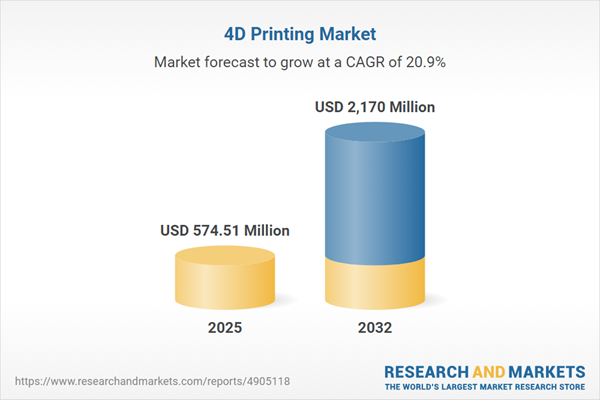Speak directly to the analyst to clarify any post sales queries you may have.
The 4D Printing Market equips senior decision-makers with transformative capabilities to enhance manufacturing agility and responsiveness in dynamic industrial environments. As organizations increasingly face operational volatility and technology-driven disruption, 4D printing delivers pathways for sustainable value creation and smarter production strategies.
Market Snapshot: 4D Printing Market Size and Growth Trajectory
As of 2024, the 4D Printing Market is valued at USD 475.67 million and demonstrates a robust compound annual growth rate (CAGR) of 20.93%. Industry analysis forecasts this sector reaching USD 574.51 million in the near term, on a path to exceed USD 2.17 billion by 2032. This pronounced expansion is propelled by steady progress in adaptive material sciences and the increasing integration of advanced manufacturing technologies. Sectors such as aerospace, automotive, and healthcare are at the forefront of adopting 4D printing to elevate process agility, operational effectiveness, and digital transformation initiatives.
Scope & Segmentation: Strategic Breakdown of the 4D Printing Market
- Offerings: Customized design services, specialized post-processing support, and advanced 4D printing hardware enable tailored end-to-end solutions for distinctive project needs, helping enterprises exceed fulfillment expectations and streamline operations.
- Material Types: Advanced composites, hydrogels, and shape memory polymers drive the development of adaptive components, helping manufacturers ensure both resilience and flexibility for demanding production environments across industrial segments.
- Printing Technologies: Fused Deposition Modeling, PolyJet, Selective Laser Sintering, and Stereolithography support precise creation of complex geometries and intricate parts, meeting a variety of end-use requirements and facilitating innovation across multiple industries.
- Applications: Usage ranges from adaptive structures in aerospace, rapid prototyping and customization in automotive, precision healthcare solutions, to responsive construction infrastructure—each case advancing efficiency and product innovation.
- Regional Markets: Distinct operational and regulatory factors shape strategy in the Americas, Europe, Middle East & Africa, and Asia-Pacific, prompting tailored market entry and compliance initiatives to optimize opportunity and limit risk exposure.
- Leading Organizations: Companies including Dassault Systèmes SE, Heineken NV, Northrop Grumman Corporation, Airbus Group SE, ANSYS Inc., Zortrax SA, HP Inc., Autodesk Inc., Materialise NV, and Stratasys Ltd. collectively set industry benchmarks for integrating smart materials and scaling novel manufacturing approaches.
Key Takeaways for Senior Decision-Makers
- Integrating 4D printing empowers enterprises to flexibly adapt product lines, services, and workflows as market expectations evolve and competition intensifies.
- Simulation and modeling capabilities streamline development processes, reducing risk during product introduction and supporting rapid refinement of complex designs.
- Innovative hardware and software solutions equip organizations for regulatory agility, allowing efficient adaptation to policy changes and technological advancements.
- Enhancing adaptive manufacturing practices and resilient supply chains ensures continued operation and responsiveness to global disruptions and shifting demand landscapes.
- Adopting sustainable materials supports corporate environmental commitments and strengthens alignment with stakeholder expectations and emerging regulatory standards.
- Flexible development strategies foster a culture of constant innovation, positioning senior leaders to capture new opportunities and maintain industry leadership.
Tariff Impact: Navigating U.S. Trade Policy in the 4D Printing Market
With evolving U.S. tariff policies affecting imports of 4D printing equipment and materials, enterprises are implementing expanded local sourcing, nearshore partnerships, and redesigned supply chains. These strategic shifts safeguard business continuity and maintain operational resilience amid regulatory uncertainty.
Methodology & Data Sources
This report is based on a blend of direct interviews with senior executives, expert insights, proprietary datasets, and thorough analysis of reputable third-party research. The multi-source methodology ensures reliable, actionable intelligence for driving strategic decisions in the 4D printing market.
Why This Report Matters
- Senior leaders receive proven strategies for digital transformation and capital allocation, supporting resilience through periods of rapid technological change.
- The findings clarify competitive pressures and regulatory complexity, equipping businesses to proactively manage risks and remain prepared for emerging disruptions.
- Actionable guidance is provided for addressing challenges across supply chain management, compliance, and sustainability, enabling sustainable growth through ongoing innovation.
Conclusion
Implementing 4D printing and related smart manufacturing solutions positions enterprises for long-term agility. Early adoption supplies a foundation for responsibly navigating shifts in industry expectations and maintaining operational excellence.
Additional Product Information:
- Purchase of this report includes 1 year online access with quarterly updates.
- This report can be updated on request. Please contact our Customer Experience team using the Ask a Question widget on our website.
Table of Contents
3. Executive Summary
4. Market Overview
7. Cumulative Impact of Artificial Intelligence 2025
Companies Mentioned
The companies profiled in this 4D Printing market report include:- Dassault Systèmes SE
- Heineken NV
- Northrop Grumman Corporation
- Airbus Group SE
- ANSYS, Inc.
- Zortrax SA
- HP Inc
- Autodesk Inc.
- Materialise NV
- Stratasys Ltd.
Table Information
| Report Attribute | Details |
|---|---|
| No. of Pages | 196 |
| Published | November 2025 |
| Forecast Period | 2025 - 2032 |
| Estimated Market Value ( USD | $ 574.51 Million |
| Forecasted Market Value ( USD | $ 2170 Million |
| Compound Annual Growth Rate | 20.9% |
| Regions Covered | Global |
| No. of Companies Mentioned | 11 |









